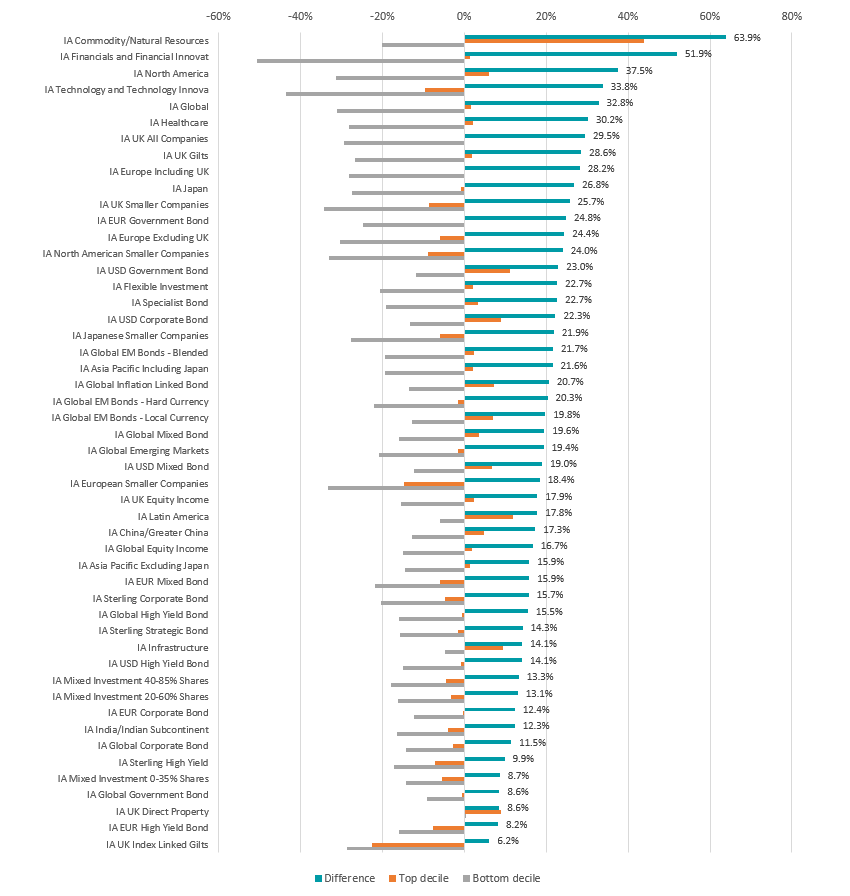A performance gap of more than 60 percentage points has emerged among the winning and losing funds in the highest returning Investment Association sector over the opening half of 2022, analysis by Trustnet shows. 
Investors have taken flight from risk assets in recent months because of surging inflation, interest rate hikes, fears of a global recession, China’s renewed Covid lockdowns and Russia’s invasion of Ukraine.
Over the past six months, the MSCI AC World index lost 11% in total return terms while the Bloomberg Global Treasury index was down 5% and Bloomberg Global Aggregate Corporates fell 5.8%. Commodities posted strong gains, however, with higher inflation sparking a 51.5% rise in the S&P GSCI index.
On a geographic basis, most major regions have posted a loss in 2022 so far. The UK has been one of the better performers after the FTSE All Share lost just 4.6%, which compares favourably with the 20% drop in the S&P 500 and the 18% slide in the Euro STOXX (in local currencies).
Performance of global equity sectors in 2022

Source: FE Analytics. Total return in sterling between 1 Jan and 30 Jun 2022
And the chart above shows how most equity sectors have tanked over the past six months – with the exception of energy which gained 28.1% after the price of oil and gas shot upwards.
The impact of this backdrop on funds’ returns has been well-covered. To recap, just 8.3% of funds in the Investment Association universe made a positive return in the first six months of 2022 – 417 out of 5,049 funds.
But, obviously, there has been some difference in fund performance – even among those that focus on the same part of the market – so this research aims to find out which sectors have the biggest gap between their best and worst members.
To this, we compared with the average return of each sectors’ top decile with the average from its bottom decile. The chart below attempt to sum all this up: the teal line shows the difference in returns between the sectors’ top and bottom deciles (with label revealing the exact gap), the orange line is the average return of the top decile and the grey the average for the bottom decile.
Difference in highest and lowest returners in 2022, by Investment Association sector

Source: FE Analytics. Total return in sterling between 1 Jan and 30 Jun 2022
As reported earlier this week, the IA Commodity/Natural Resources sector is the peer group that has made the highest average return this year, reflecting asharp bounce in the prices of energy, agricultural commodities and many other key raw materials.
However, our research shows that it’s also the area where fund selection has arguably been the most important as there is a 63.9 percentage point difference between the funds in the sector’s top decile and its bottom.
In the first decile can be found iShares S&P 500 Energy Sector UCITS ETF (up 46.8%), Xtrackers MSCI USA Energy UCITS ETF (46.1%) and BlackRock BGF World Energy (38.9%). These funds are among the highest returning funds of the entire Investment Association universe this year – indeed, the top spot is held by iShares S&P 500 Energy Sector UCITS ETF.
However, a residency in the IA Commodity/Natural Resources sector has not been a guarantee of high returns. In the bottom decile we see the likes of Pictet Clean Energy (down 23%), iShares Global Water UCITS ETF (down 18.8%) and Pictet Water (down 18.1%).
In the IA Financials and Financial Innovations sector, there’s a 51.9 percentage point gap between the first decile – which comprises two funds: Polar Capital Global Insurance (up 10.5%) and Xtrackers MSCI World Financials UCITS ETF (down 7.9%) – and the bottom decile.
The two funds in the tenth decile are HAN ETC Group Digital Assets & Blockchain Equity UCITS ETF, which has lost 67.7%, and Jupiter Global Financial Innovation, which is down 33.5%.
Ending with a look at the industry’s biggest peer group, the IA Global sector has a 32.8 percentage point gap between its best and worst funds.
Commodity funds such as SSGA SPDR MSCI World Energy UCITS ETF, Schroder ISF Global Energy and iShares Agribusiness UCITS ETF sit in the first decile alongside value strategies like Nedgroup Contrarian Value Equity, Kennox Strategic Value, JOHCM Global Opportunities, Jupiter Global Value Equity and Schroder Global Recovery.
In the bottom decile are funds that focus on the growth style of investing, technology and/or small companies, such as HAN Global Online Retail UCITS ETF, Baillie Gifford Global Discovery and ASI Global Smaller Companies.





